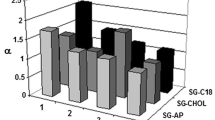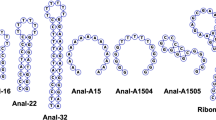Abstract
We report for the first time the use of liquid-liquid counter-current chromatography (CCC) for the preparative scale fractionation of plasmid DNA. Almost complete fractionation of supercoiled and open circular plasmid DNA (6.9 kb) could be achieved using a phase system comprising 12.5% (w/w) PEG 600 and 18% (w/w) K2HPO4. Experiments were carried out on a Brunel J-type CCC machine (100 ml PTFE coil) at a mobile phase flow rate of 0.5 ml min− 1 and a rotational speed of 600 rpm. Compared to conventional HPLC techniques the capacity of CCC is not limited by the surface area of resin available for adsorption.
Symbols: C b, Concentration of plasmid in lower phase (μg ml−1); C t, Concentration of plasmid in upper phase (μg ml−1); CV, Total volume of mobile phase present in the coil and connecting leads (ml); K, Equilibrium solute partition coefficient (K=C t/C b); OC, Open circular plasmid; SC, Supercoiled plasmid; S f, Percentage stationary phase retention (S f=V s/V c); t s, Time for phase separation (s); V b, Volume of bottom phase (ml); V c, Coil volume (ml); V m, Volume of mobile phase present in coil at equilibrium (ml); V r, Volume ratio of two phases (V r=V t/V b); V s, Volume stationary phase present in coil at equilibrium (ml); V t, Volume of top phase (ml); V tot, Total volume of phase system (ml).
Similar content being viewed by others
References
Albertsson P-A (1965) Partition studies on nucleic acids. Biochim. Biophys. Acta 103: 1-12.
Bergan D, Galbraith T, Sloane DL (2000) Gene transfer in vivo and in vitro by cationic lipids is not significantly affected by levels of supercoiling. Pharm. Res. 17: 967-973.
Birnboim HC, Doly J (1979) A rapid alkaline extraction process for screening recombinant plasmid DNA. Nucl. Acids Res. 7: 1513-1521.
Bonilla PJ, Freytag SO, Lutter LC (1991) Enhancer-activated plasmid transcription complexes contain constrained supercoiling. Nucleic Acids Res. 19: 3965-3971.
Booth AJ, Lye GJ (2001) Optimisation of the fractionation and recovery of polyketide antibiotics by counter-current chromatography. J. Liq. Chrom. Rel. Technol. (In press).
Conway WD (1990) Counter Current Chromatography: Apparatus, Theory and Applications. New York: VCH Publishers.
Diamond AD, Hsu JT (1992) Aqueous two-phase systems for biomolecule separation. Adv. Biochem. Eng. Biotechnol. 47: 89-135.
Durland RH, Eastman EM (1998) Manufacturing and quality control of plasmid based gene expression system. Adv. Drug Del. Rev. 30: 33-48.
Elles R, Sutherland I (1980) Purification of specific restriction fragments of human deoxyribonucleic acid by using liquid countercurrent chromatography. Biochem. Soc. Trans. 8: 173.
Favre J, Pettijohn DE (1967) A method for extracting purified DNA or protein-DNA complex from Escherichia coli. Eur. J. Biochem. 3: 33-41.
Green AP, Prior GM, Helveston NM, Taittinger BE, Liu X, Thompson JA (1997) Preparative purification of supercoiled plasmid DNA for therapeutic applications. Biopharmacology 10: 52-62.
Horn NA, Meek JA, Budahazi G, Marquet M (1995) Cancer gene therapy using plasmid DNA — purification of DNA for human clinical trials. Hum. Gene Ther. 6: 565-573.
Ito Y, Conway WD (1996) High Speed Counter Current Chromatography. New York: John Wiley & Sons Inc.
Ito Y, Matsuda K, Ma Y, Qi L (1998) Toroidal coil counter-current chromatography study of the mass transfer rate of proteins in aqueous-aqueous polymer phase system. J. Chromatogr. A802: 277-283.
Levy MS (2000) Quantitation of supercoiled content in plasmid DNA solutions using a fluorescence-based method. Nucleic Acids Res. 28: 57.
Levy MS, Collins IJ, Tsai JT, Shamlou PA, Ward JM, Dunnill P (2000a) Removal of contaminant nucleic acids by nitrocellulose filtration during pharmaceutical-grade plasmid DNA processing. J. Biotechnol. 76: 197-205.
Levy MS, Collins IJ, Yim SS, Ward JM, Titchener-Hooker N, Shamlou PA, Dunnill P (1999) Effect of shear on plasmid DNA in solution. Bioprocess Eng. 20: 7-13.
Levy MS, O'Kennedy RD, Ayazi-Shamlou P, Dunnill P (2000b) Biochemical engineering approaches to the challenges of producing pure plasmid DNA. Trends Biotechnol. 18: 296-305.
Li S, Huang L (2000) Non-viral gene therapy: promises and challenges. Gene Ther. 7: 31-34.
Lin P-C, Chu I-M (1995) Separation of cephalosporin C and desacetyl cephalosporin C by high speed counter-current chromatography in aqueous two-phase systems. Biotechnol. Tech. 9: 549-552.
Marquet M, Horn NA, Meek JA (1995) Process development for the manufacture of plasmid DNA vectors for use in gene therapy. Biopharmacology 8: 26-37.
Middaugh CR, Evans RK, Montgomery DL, Casimiro DK (1998) Analysis of plasmid DNA from a pharmaceutical perspective. J. Pharm. Sci. 87: 130-146.
Mountain A (2000) Gene therapy: the first decade. Trends Biotechnol. 18: 119-128.
Murphy JC (1999) Purification of plasmid DNA using selective precipitation by compaction agents. Nature Biotechnol. 17: 822-823.
Nochumson S, Warner T, Pora H (2000) Purification of plasmid DNA using a new generation of anion exchange membrane adsorbers. Bioeurope. December 11–13, Lake Konstanz, Germany.
Noites IS, O'Kennedy RD, Levy MS, Abidi N, Keshavarz-Moore E (1999) Rapid quantitation and monitoring of plasmid DNA using an ultra sensitive DNA binding dye. Biotechnol. Bioeng. 66: 195-207.
Prazeres DMF, Ferreira GNM, Monteiro GA, Cooney CL, Cabral JMS (1999) Large-scale production of pharmaceutical-grade plasmid DNA for gene therapy: Problems and bottlenecks. Trends Biotechnol. 17: 169-174.
Ribeiro SC, Monteiro GA, Martinho G, Cabral JMS, Prazeres DMF (2000) Quantitation of plasmid DNA in aqueous two-phase systems by fluorescence analysis. Biotechnol. Lett. 22: 1101-1104.
Robinson HL, Ginsberg HS, Davis HL, Johnston SA, Lui MA (1997). The scientific future of DNA for immunisation. A Report from the American Academy of Microbiology. Washington, DC: American Academy of Microbiology.
Rudin L, Albertsson P (1966) A new method for the isolation of deoxyribonucleic acid from microorganisms. Biochim. Biophys. Acta 134: 37-44.
Sambrook J, Fritsch EF, Maniatis T (1989) Molecular Cloning — A Laboratory Manual. Cold Spring Harbor: Cold Spring Harbour Laboratory Press.
Schleef M (1999) Issues for large-scale plasmid DNA manufacturing in Biotechnology 2nd ed. In: Rohm HJ, Reed G (eds), Biotechnology, Vol. 5a. Weinheim: Wiley-VCH, pp. 443-470.
Shibusawa Y, Hosojima T, Nakata M, Shindo H, Ito Y (2001) One step purification of cholinesterase from human serum by countercurrent chromatography. J. Liq. Chrom. Rel. Technol. (in press).
Shinomiya K, Menet J-M, Fales HM, Ito Y (1993) Studies on a new cross-axis coil planet centrifuge for performing counter current chromatography. 1. Design of the apparatus, retention of the stationary phase, and efficiency in the separation of proteins with polymer phase systems. J. Chromatogr. 644: 215-299.
Sutherland IA, Brown L, Forbes S, Games G, Hawes D, Hostettmann K, McKerrell EH, Marston A, Wheatley D, Wood P (1998). Countercurrent chromatography (CCC) and its versatile application as an industrial purification & production process. J. Liq. Chrom. Rel. Technol. 21: 279-298.
Sutherland IA, Brown L, Graham AS, Guillon GG, Hawes, D, Janaway L, Whiteside R, Wood P (2001). Industrial scale-up of countercurrent chromatography: Predictive scale-up. J. Liq. Chrom. Rel. Technol. (In press).
Walter H, Brooks DE and Fisher D (1985) Partitioning in Aqueous Two-phase Systems. Orlando, FL: Academic Press Inc.
Wils P, Escriou V, Warnery A, Lacriox F, Langneaux D, Ollivier M, Crouzet J, Mayaux JF, Scherman D (1997) Efficient purification of plasmid DNA for gene transfer using triple-helix affinity chromatography. Gene Ther. 4: 323-330.
Author information
Authors and Affiliations
Corresponding author
Rights and permissions
About this article
Cite this article
Kendall, D., Booth, A., Levy, M. et al. Separation of supercoiled and open-circular plasmid DNA by liquid-liquid counter-current chromatography. Biotechnology Letters 23, 613–619 (2001). https://doi.org/10.1023/A:1010362812469
Issue Date:
DOI: https://doi.org/10.1023/A:1010362812469




